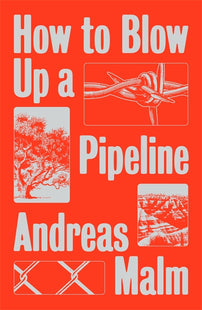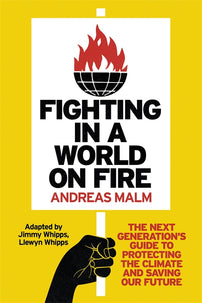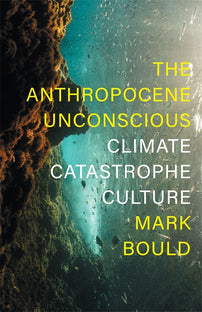When the cup of endurance runs over
It begins with a slashed SUV tire...

In The Anthropocene Unconscious, Mark Bould considers how the destabilisation of the climate manifests in texts that are not overtly about climate change. Here, he considers the film adaptation of How To Blow Up A Pipeline (dir Daniel Goldhaber).
See our Earth Day reading list here!
It’s about attacking the things that attack us
And it begins with a flipped-up hoodie, a quick scan of the street for possible witnesses, and the knifing of an SUV tire…
The opening credits state How to Blow Up a Pipeline (2022) is ‘based on’ Andreas Malm’s 2021 book of the same name, but I’d say ‘inspired by’ is more accurate. (For example, when Malm recounts the deflation of SUV tires in wealthy Stockholm neighbourhoods, it is by non-destructively inserting a mung bean, couscous grain or peppercorn into their valves.)
[book-strip index="1"]
Part-theory, part-memoir, all-polemic, Malm’s book, less a call to arms than a heavy-hint-to-arms, poses particular problems for the adapter. With a nonfiction source, documentary might seem the obvious way to go. But historical dramas all the time reconcile ‘real-life’ characters and situations to the narrative obstacles, complications and resolutions of the Hollywood three-act structure, and biopics, the complexities of a life to the demands of the rise-and-fall-and-rise-again story arc. And if the challenge looks too great, there’s always the metafictional Adaptation (2002), Charlie Kaufman and Spike Jonzes’s successful failure to adapt Susan Orleans’s The Orchid Thief (1998) – not to mention Sergei Eisenstein’s differently instructive complete failure to ever actually make that movie of Capital.
But perhaps the closest parallel is Amitav Ghosh’s novelisation of his own The Great Derangement: Climate Change and the Unthinkable (2016) as the globe-trotting cli-fi thriller Gun Island (2019). Screenwriters Ariela Barer and Jordan Sjol and director Daniel Godhaber treat Malm’s book as a springboard. Rather than outline his argument, they tell the story of eight twentysomethings – most of whom you’re more likely to recognise from television than film – who come together to blow up a Texas pipeline. They all have their reasons.
Xochitl (Runaways’ Ariela Barer), who recently lost her mother in a freak heatwave, is tired of protesting so much and achieving so little. Her best friend, Theo (American Honey’s Sasha Lane), has the kind of leukaemia that clusters around chemical plants and oil refineries, like the one where they grew up; without treatment it is fatal, and she does not have health insurance. Her partner, Alisha (The First Lady’s Jayme Lawson) is already grieving but trying not to show it. Michael (Panhandle’s Forrest Goodluck) is furious at the exploitation of Indigenous lands for oil extraction and cannot bring himself to work for a seed-conservation charity just to make ‘white people feel better’ about themselves. Dwayne (Animal Kingdom’s Jake Weary) is equally angry: his land, in the family for over a hundred years, has been seized under eminent domain for pipeline construction, displacing his young family to a trailer park. And so on.
This rag-tag band is no dirty dozen, no seven samurai. They are not even the professional criminals of Rififi (1955), whose quietly orchestrated heisting competence is so easy to admire. They are amateurs, new to all this. Not all of them are even environmentalists. They are mainly the people least able to risk arrest at a non-violent protest; they are street kids, unemployed, minimum wage workers, marginalised, some queer, most of colour. Self-taught in the ways of sabotage, they are part of an emerging radical flank, monkeywrenchers who, unlike Earth First! or the Earth Liberation Front, exist alongside and in ‘dynamic relation to a mass movement’ (Malm 155). They are not perfect, but their planned action is not just, as Theo jokes, ‘a big fuck-you to the people who did this’. It is justified self-defence against the no-longer-quite-so-slow violence scorching the planet.
And they do not all agree about everything. In a key scene, drawing on Malm, the group, some drunk, some stoned, some both, chafe each other about whether they are or will be labelled ‘terrorists’, hint at the erasure of the role of violence in successful ‘non-violent’ struggles, and question the nature of collateral damage and where it is likeliest to fall. Alisha talks about how long it will take to build something new, but Michael is only interested in tearing down the old. It is hardly the remarkable semi-improvised collectivisation debate in Ken Loach’s Land and Freedom (1995). But it is also very importantly not On Deadly Ground (1994), the one where Steven Seagal spends a $50 million dollar budget and every ounce of his directorial talents culturally appropriating Indigenous costumes and lifeways for 90 minutes before blowing up an oil rig to (somehow) save the pristine arctic north and then seven further minutes preaching about environmentalism before allowing the credits to role (it seems much longer, I know, and until an appropriately disastrous preview screening it was).
If there really must be unearned suffering…
None of the film’s characters have done anything to earn their grief, their loss, their despair. Malm rightly disparages the Gandhian notion, reiterated by XR, Bill McKibben and other non-violence fetishists, that there is spiritual value to be derived from taking on unearned suffering. There is more than enough suffering caused by fossil capital to go around. It is just not very evenly distributed. And if the plan of the ruling class, of corporations and nation-states, so far as they have one, is to perpetuate both the suffering and its inequitable distribution then, as Malm suggests, perhaps it is already well past time to tactically deploy violence – against property in the first (and for the longest) instance, and under constant review, as the whole array of tactics should be.
Individual acts of sabotage are no more meaningful in the grand scale of things than sorting your recycling. Like the Pentagon, saboteurs must look for force multipliers. By hitting this particular pipeline, the characters calculate an immediate impact on oil prices – slight and short-lived, but nonetheless serving notice that, even with all those trillion-dollar subsidies, investing in fossil fuels is no longer going to be comfortably profitable. In other cases, it might be less about a particular juncture and more about the frequency and geographical dispersal of sabotage.
But in all cases, it is about articulating the why of it all loudly and clearly and widely. Ultimately, Xochitl and Theo take this upon themselves, even though they, like us, live in a world where pouring sugar in a gas tank can be defined as ‘destruction of critical infrastructure on federal property’, that is, as terrorism carrying 15 years of jail time.
The non-violent civil disobedience playbook demands that we ‘submit to the law’ (Malm 122), to the punitive violence of the state and its agents. Therefore, the DAPL saboteurs Jessica Reznicek and Ruby Montoya outed themselves and voluntarily faced 110 years each. Nothing they did deserved that much suffering, or even the single-figure years’ worth, to which they were eventually sentenced. But at least their willingness to take their lumps did signal ‘to others that this is worth fighting for’ (Malm 122).
[book-strip index="2"]
To the Fina station!
Timothy Mitchell’s Carbon Democracy argues that the turn to oil was partly about chokepoints in the coal infrastructure where organised labour, in the struggle to distribute wealth more equitably, could block the energy supply. However, at least part of capital’s solution is also vulnerable to interdiction. From the 1936 Palestinian general strike to the Movement for the Emancipation of the Niger Delta in 2005–2008 and the 2011 Egyptian Revolution, from Naxalites in India to Houthi rebels in Yemen, pipelines – and other parts of the infrastructural web – have proven very easy to sabotage, albeit not yet really as part of the struggle against climate destabilisation (Malm 70–9).
And, as the film shows in the background of its various settings, the infrastructure is everywhere: nodding donkey pumpjacks in scrubby West Texas; a Californian refinery, just a chain-link fence or two away from people’s homes; North Dakota oil wells mere yards from the temporary housing for out-of-state oil workers, the orange flames of natural gas burn-off illuminating the snow-covered (and until just recently Indigenous) land.
City and country, desert and snowfield, east and west, north and south, the infrastructure is ubiquitous.
As are the over-the-counter ingredients and instructional TikToks needed to blow up a pipeline (although the film’s procedural montages are keep-the-lawyers-happy ambiguous about how precisely to make explosives and detonators).
The dreadful calculus of the Children of Kali
In Kim Stanley Robinson’s The Ministry for the Future (2020), a heat wave in India produces wet-bulb temperatures so high that 20 million people die in a week. In the aftermath, a shadowy group called the Children of Kali decides to stop the further dumping of CO2 into the atmosphere by any means necessary. Their first action, the one with which they announce their presence to the world, is to bring down so many passenger jets so indiscriminately that, in one day, commercial air travel dies.
The Children of Kali work in the margins. They are not the heroes, or even the protagonists, of Robinson’s polyphonic novel. Key roles are played by Indian geoengineers who unilaterally set out to slow global warming, scientists who innovate a way to prop up an Antarctic ice shelf, and block-chain tech-geeks who create a global currency the value of which is tied to decarbonisation. But the primary actor is the eponymous ministry, a UN organisation extrapolated from a clause in the Paris Agreement and charged with acting for all the living beings, present and future, who cannot speak for themselves.
And this is precisely the conundrum we face: ‘at the end of the day, it will be states that ram through the transition or no one will’ (Malm 69), but they clearly have no desire to do so.
Although there is more than a hint of Agent Coulson to the way Shawn (Black-ish’s Marcus Scribner) brings Dwayne into the group, at the end of the film, Nick Fury does not step forward from the shadows to recruit anyone. This is because, as we see in the film, the US is a failed state. As is any that will not provide universal healthcare free at the point of need, will not alleviate homelessness or feed the hungry and impoverished, let alone protect its citizens from the effects of pollution and accumulating atmospheric CO2 or rapidly transition from fossil fuels. It is Hydra, all the way down.
Consequently, non-violent protest (on its own) is not working and will not work – not enough, nor quickly enough. So we must ask, along with Gerry Canavan, ‘What if political violence has a role to play in saving the future? What if you actually can’t beat the bastards playing by their rules in the institutions they buy and sell?’
An essential part of Malm’s book – towards which the film can only vaguely gesture – is an epic 25-page takedown of the misrepresentation of historical struggles that underpins Extinction Rebellion’s grand strategy. From abolitionism and suffragism, through Indian national liberation, the Civil Rights movement, the Iranian revolution and the ending of Apartheid, to the toppling of Eastern Bloc dictators and the Arab Spring, XR claims that non-violent struggle was the only effective strategy, the one thing that could – and did – win.
Malm calls bullshit.
In many such struggles, non-violence was a key mass-movement tactic, but – like Martin Luther King himself – it often had armed protection. And more importantly, was surrounded by more radical alternatives. To the extent the White House welcomed MLK, it was because the alternatives were Robert F. Williams, Malcolm X, the Black Panthers…
Gandhi might have preached non-violence in the struggle against British rule (which never stopped him from volunteering Indians to die in wars on behalf of the Empire), but ‘from the mutiny of 1857 to that of 1946’, it was as much ‘subaltern violence’ as satyagraha that ‘marked the route to India’ (Malm 46).
Nelson Mandela’s 27 years in captivity might have transformed him into some kind of saint, but he was imprisoned for a reason. After the Sharpeville massacre, he argued for and became the first commander of the ANC’s uMkhonto we Sizwe, the Spear of the Nation, responsible for extending the struggle through violence against the physical infrastructure of oppression…
And when the Suffragettes’ legal manoeuvres were stymied, they seem to have enjoyed nothing so much as getting out there and fucking shit up: breaking windows, torching post boxes, smashing statues, destroying paintings, dogwhipping politicians…
These are all examples of what Malm calls the ‘fine art … of controlled political violence’ (110). In each case, a radical flank so unsettles the status quo that suddenly the non-violent mass-movement’s demands become much more palatable to national and supra-national agents.
Most of us, like the film’s Alisha, must undertake the hard work of collectively constructing low-, zero- and negative-emission ways of living. This cannot be left to price-mechanisms, since they are the very means by which the unearned suffering of climate catastrophe is inequitably distributed. And as the many lethal and costly fiascos of Covid taught us, if we do not act to reorganise the way the chips fall, they will fall where the world-system is designed to make them fall.
But to some, like Xochitl and Theo, falls the unenviable task of sweeping the old world away. They must exile themselves from the mass movement but remain faithful to it, even as they endure its (strategically necessary but also often heartfelt) condemnation. Only by leaving can they ensure that mass movement’s ‘success’, which ‘is neither certain nor probable’ becomes ‘possible’ (Malm 147).
Let us hope, though, this fraction can resolve the dreadful calculus of our times without becoming like the Children of Kali. That their violence will only ever be used against inanimate infrastructure and property. That your air miles and butcher’s bills and shitty gas mileage never become your death warrant.
The clock is ticking.
Divest now, motherfuckers!
In her leukaemia support group, Theo says something clichéd about learning to use her anger, rather than letting it control her. But she is right. As China Miéville exhorts, it’s about feeling hate beyond words, and bringing it to bear.
It begins with a slashed SUV tire, and it ends with disabling luxury yachts.
For now...
[book-strip index="3"]



